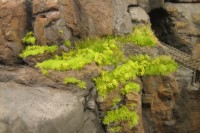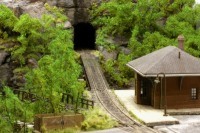
Greenery, Part 3 of 3: Trees
One of the reasons it's hard to find really good commercial trees is that really good trees are difficult to make. The better-looking the tree, the more costly it will be; at some point one hits a point of diminishing returns, and they just won't get any better.
The alternative to forking over a pile of green for some good trees is to make them yourself. For me, though, time is the more precious commodity, so I've been searching high and low for commercial trees that can bear the scrutiny of a picky eye and a macro lens.
Another reason it's hard to find really good trees is because 98% of all commercial trees represent what I call "lawn trees." These are the trees we see in neighborhoods. While we certainly need these trees, chances are we'll need even more of the variety found in forests, and no one makes these.

This rugged area next to Frisch Falls starts with grasses, weeds and shrubs.

After the groundcover is applied, trees are planted.
Forest trees bear characteristics that starkly distinguish them from lawn trees. For one, many different types of trees share very similar shapes: they're tall, slender, and fan out at the top. This is nature's way of allowing them to obtain the most sunlight possible; lower branches die off as they receive progressively less light.
Compare forest trees to lawn trees, which have distinctive profiles—the shapes that allow us to identify them at a glance—and thick leafy coverage on all sides, from the bottom up. It's easy to tell an oak from an elm; but in the forest, one must check the bark and leaf shape to be sure.
Since no one makes forest trees, I set out in search of a tree type that might be easily modified into a generic forest tree. The closest I've come so far are beech trees from SAM Trees. With some careful branch bending and foliage adjustment, these top-heavy trees can become good generic forest trees. For spindly saplings and "weed trees", I use SAM Trees bamboo bunches. I carefully split the bunches apart to obtain 8-10 individual saplings.
But as fine as SAM Trees are (I'd rate them the best of all commercial sources), they share one glaring flaw with the vast majority of commercial trees: their trunks are painted brown. Tree bark is not brown! That's the kindergarten concept of trees. Tree bark is grey. Walk out into a forest (or just your yard, for that matter) and see for yourself. I also tone down the brilliant yellow-green color because it does not photograph well. I spray the trees lightly with class stain thinned with alcohol.
Commercial model conifers suffer from the same "lawn tree" proportions as their deciduous counterparts. While the shapes of forest conifers differ substantially from those of broadleaf trees, they still share the characteristics of being top-heavy, with few to no lower branches. So far I've not found a commercial source of conifers to my liking.
About tree size: Real trees are big... much, much bigger than most modelers tend to think—or at least choose for their layouts. This error is reinforced by manufacturers that sell trees which are woefully undersized for the stated scale. In actuality, trees sold for HO would be just about right for Z. True! That said, small layouts such as the James River Branch would look strange with correctly-sized trees; they'd appear out of proportion. So, tree size must be carefully chosen for a balanced appearance.
Copyright © 2007-2013 by David K. Smith. All Rights Reserved.